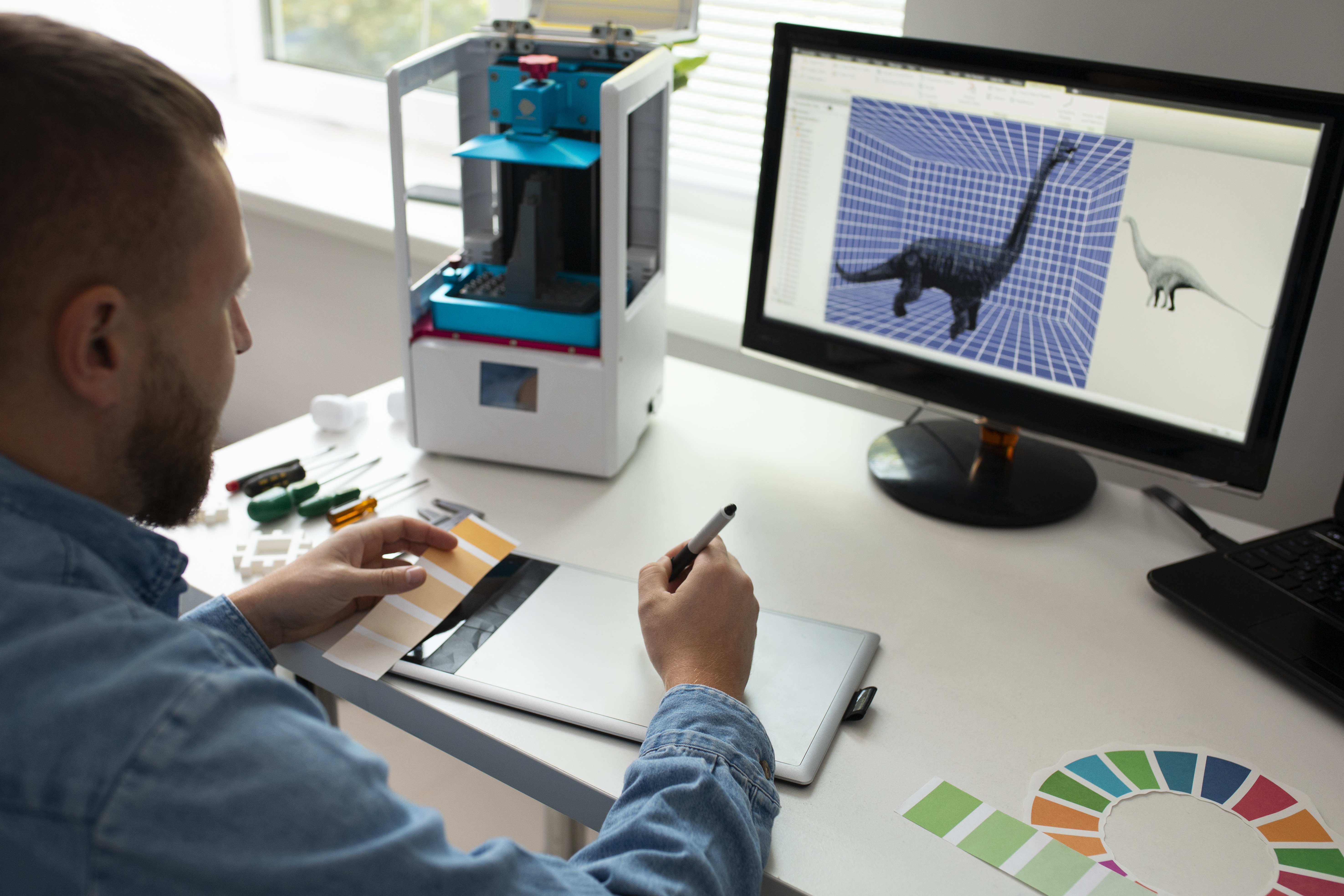Blog Posts & Blog Archives
All Blogs / technology-and-research
How 3D Printing is Revolutionising Industries
Discover how 3D printing is transforming industries, offering faster production, cost savings, and unparalleled customisation possibilities.
Monday, December 16, 2024
How 3D Printing is Revolutionising Industries
3D printing has emerged as a revolutionary technology in the manufacturing and production domains, transforming industries globally. Often called additive manufacturing, three-dimensional printing reduces costs, speeds up production, and offers unparalleled customisation possibilities. 3D printing has many applications, ranging from quick product prototyping to manufacturing complex parts for industries like aerospace and healthcare.
The Rise of 3D Printing:
The process of layering materials to create three-dimensional objects using a digital model is called additive manufacturing, or 3D printing. Additive manufacturing creates things from the ground up, reducing waste and increasing efficiency in contrast to traditional manufacturing processes, which frequently require cutting, shaping, or molding materials. Since its origins in the 1980s, this technology has substantially improved. 3D printing was first developed for quick prototyping, but it has now evolved into a multipurpose technology that can be used to create everything from common consumer goods to specialist parts for aerospace and medical applications.
Key Applications of 3D Printing in Industries
1. Manufacturing and Prototyping
One of the most significant impacts of 3D printing has been in the field of rapid prototyping. Traditionally, developing a prototype involved significant time and costs, with manufacturers needing to create molds or tooling for each design iteration. With 3D printing, manufacturers can quickly produce a prototype, make changes, and print new versions in a fraction of the time, without the need for specialised equipment.
Prototyping quickly has shortened the product development cycle considerably, allowing companies to innovate faster and respond to market demands more quickly. Moreover, 3D printing makes it easier for businesses to produce goods on demand, allowing them to avoid maintaining significant inventories. They may now produce components as needed, which reduces waste and storage expenses.
2. Healthcare:
By offering customised solutions, 3D printing is transforming patient care in the healthcare sector. Additive printing makes it possible to produce medical equipment that are precisely tailored to fit each patient and function at their peak, from dental implants to prostheses. Additionally, 3D-printed models can help surgeons plan intricate procedures, which can result in better outcomes. Bioprinting, the process of creating tissues and organs from live cells, is one of the most promising technological developments. While this technology is still in its infancy, it has the potential to revolutionise organ transplantation by providing patients with personalised, 3D-printed organs.
3. Aerospace and Automotive:
In industries like aerospace and automotive, 3D printing is used to produce complex parts that are both lightweight and highly durable. The ability to create intricate designs with internal structures that would be impossible with traditional methods gives engineers greater freedom to innovate. By reducing the weight of parts, 3D printing also helps improve fuel efficiency in vehicles and aircraft, contributing to sustainability efforts. Additionally, the customization and on-demand production capabilities of additive manufacturing allow manufacturers to create spare parts more efficiently, reducing downtime in production lines.
4. Architecture and Construction:
3D printing is also being applied to architecture and construction, where it enables the creation of complex structures with greater design freedom. Architects can now use additive manufacturing to build intricate models, experiment with new materials, and bring unique designs to life. In some cases, entire buildings are being 3D printed using specialised large-scale printers. Moreover, 3D printing in construction has the potential to reduce waste and lower the environmental impact of building projects. By using materials more efficiently and minimising the need for traditional construction methods, additive manufacturing is contributing to more sustainable practices in the industry.
5. Consumer Goods:
Mass customisation in consumer products is entering a new age made possible by 3D printing. Nowadays, businesses are able to provide customised goods that satisfy specific needs, such as eyeglasses, shoes, or home decor. Before their items are 3D printed and sent, customers can even alter and create them online. With this degree of personalization, firms can interact with customers in new ways and offer them one-of-a-kind, made-to-order goods that weren't previously possible through conventional production.
The Benefits of 3D Printing
1. Customization
The ability of 3D printing to create highly personalised objects is one of its main advantages. Unlike conventional manufacturing processes, which rely on templates and drawings, additive manufacturing makes it possible to create one-of-a-kind products that are especially catered to each user's wants and preferences. This capability is especially helpful in the healthcare and consumer goods industries, as customised products increase customer happiness and personalised medical equipment can improve patient outcomes.
2. Cost Efficiency
Conventional manufacturing techniques usually need large expenditures for setup, molds, and tooling. Nevertheless, a lot of these expensive obstacles are eliminated by 3D printing. Companies may produce goods using additive manufacturing in lieu of expensive molds or specialised equipment, which reduces overhead and production costs. Additionally, because 3D printing uses exactly the exact quantity of material needed to produce the product, it greatly decreases material waste. This waste reduction encourages more sustainable behaviours in addition to economic savings.
3. Speed and Flexibility
Businesses may introduce items far faster with 3D printing than with conventional production techniques. The capacity to rapidly design prototypes, make modifications, and generate new iterations shortens the time required for product development. Because of their agility, firms may experiment with new ideas more often, adjust to changes in market demand, and stay one step ahead of their competitors.
4. Complexity and Design Freedom
Additive manufacturing opens up new possibilities for creating complex designs and structures that would be impossible with traditional manufacturing methods. Engineers and designers can experiment with intricate geometries, internal structures, and lightweight materials, offering greater innovation potential. The ability to design without the limitations of traditional manufacturing processes encourages creativity and innovation across multiple industries.
The Future of 3D Printing
As 3D printing technology continues to advance, its impact on industries will only grow. Future developments could include the widespread use of bioprinting in healthcare, large-scale 3D printing of homes and buildings, and further advancements in customization for consumer goods. Additionally, improvements in materials and printers will likely make 3D printing more accessible and cost-effective, leading to increased adoption across a wider range of sectors.
Conclusion :
The rise of 3D printing is reshaping industries by enabling faster production, reducing costs, and offering unprecedented levels of customization. From rapid prototyping in manufacturing to personalised healthcare solutions and complex aerospace parts, additive manufacturing is unlocking new possibilities for innovation and growth. As the technology continues to evolve, businesses that embrace 3D printing will be well-positioned to thrive in an increasingly competitive global market.
Related Blogs
The Future of Job Searching
Unveil the future of job searching with a focus on technology, global connectivity & the shift towards remote work. Navigate the evolving job market's impacts.
By WelinkJobs | Friday, March 22, 2024
Top 7 Emerging Technologies Shaping the Future of Education
Discover the top 7 emerging technologies shaping the future of education. From AI to VR, explore how these innovations are shaping the future of learning.
By WelinkJobs | Wednesday, January 10, 2024



